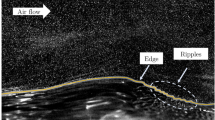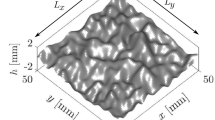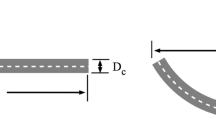Abstract
The response of a turbulent boundary layer to a short roughness strip is investigated using laser Doppler velocimetry (LDV) and laser induced fluorescence (LIF). Skin friction coefficients are inferred from accurate near-wall measurements. There is an undershoot in \(c_f /c_{f_0 } \), where \(c_{f_0 } \) is the undisturbed smooth wall skin friction coefficient, immediately after the strip. Downstream of the strip, \(c_f /c_{f_0 } \) overshoots before relaxing back to unity in an oscillatory manner. The roughness strip has a major effect on the turbulent stresses \(\left( {\overline {u^2 } ,\overline {v^2 } , - \overline {uv} } \right) \); these quantities increase, relative to the undisturbed smooth wall, in the region between the two internal layers originating at the upstream and downstream edges of the strip. The increase in the ratio\({\overline {v^2 } /\overline {u^2 } } \) suggests a decrease in near-wall anisotropy. From the flow visualizations, it is inferred that streamwise vortical structures are weakened immediately downstream of the strip. Consistently, streamwise length scales are also reduced; direct support for this is provided by measured two-point velocity correlations.
Similar content being viewed by others
References
Andreopoulos, J. and Wood, D.H., The response of a turbulent boundary layer to a short length of surface roughness. J. Fluid Mech. 118 (1982) 143–164.
Antonia, R.A. and Luxton, R.E., The response of a turbulent boundary layer to an upstanding step change in surface roughness. J. Basic Eng. 93 (1971) 22–34.
Antonia, R.A., Browne, L.W.B. and Bisset, D.K., Effect of Reynolds number on the organized motion in a turbulent boundary layer. In: Kline, S.J. and Afgan, N.H. (eds), Near-Wall Turbulence. Hemisphere, New York (1990) pp. 488–506.
Blackwelder, R.F. and Kovasznay, L.S.G., Time scales and correlations in a turbulent boundary layer. Phys. Fluids 15 (1972) 1545–1554.
Bushnell, D.M. and McGinley, C.B., Turbulence control in wall flows. Ann. Rev. Fluid Mech. 21 (1989) 1–21.
Djenidi, L. and Antonia, R.A., LDA measurements in a low Reynolds number turbulent boundary layer. Expts. in Fluids 14 (1993) 280–283. Erratum, Expts. in Fluids 15 (1993) 386.
Dumas, R., Observations on the boundary layer based on measured correlations with various improvements. In: Kline, S.J. and Afgan, N.H. (eds), Near-Wall Turbulence. Hemisphere, New York (1991) pp. 437–452.
Head, M.R. and Bandyopadhyay, P.R., New aspects of turbulent boundary layer structure. J. Fluid Mech. 107 (1981) 197–338.
Karlsson, R.I., Near-wall measurements of turbulent structure in boundary layers and wall jets. In: So, R.M.C., Speziale, G.C. and Launder, B.E. (eds), Near-Wall Turbulent Flows Elsevier, Amsterdam (1993) pp. 423–432.
Schofield, W.H., Turbulent shear flows over a step change in surface roughness. J. Fluids Engrg. 103 (1981) 344–351.
Smith, C.R. and Metzler, S.P., The characteristics of low-speed streaks in the near-wall region of a turbulent boundary layer. J. Fluid Mech. 129 (1983) 27–54.
Smits, A.J. and Wood, D.H., The response of turbulent boundary layers to sudden perturbations. Ann. Rev. Fluid Mech. 17 (1985) 321–358.
Spalart, P.R., Direct simulation of a turbulent boundary layer up to R ϑ = 1410. J. Fluid Mech. 187 (1988) 61–98.
Taylor, R.P., Taylor, J.K., Hosni, M.H. and Coleman, H.W., Relaxation of the turbulent boundary layer after an abrupt change from rough to smooth wall. J. Fluids Engrg. 115 (1993) 379–382.
Zhou, Y. and Antonia, R.A., Convection velocity measurements in a cylinder wake. Expts. in Fluids 13 (1992) 63–70.
Author information
Authors and Affiliations
Rights and permissions
About this article
Cite this article
Pearson, B., Elavarasan, R. & Antonia, R. Effect of a Short Roughness Strip on a Turbulent Boundary Layer. Flow, Turbulence and Combustion 59, 61–75 (1997). https://doi.org/10.1023/A:1000861915585
Issue Date:
DOI: https://doi.org/10.1023/A:1000861915585




